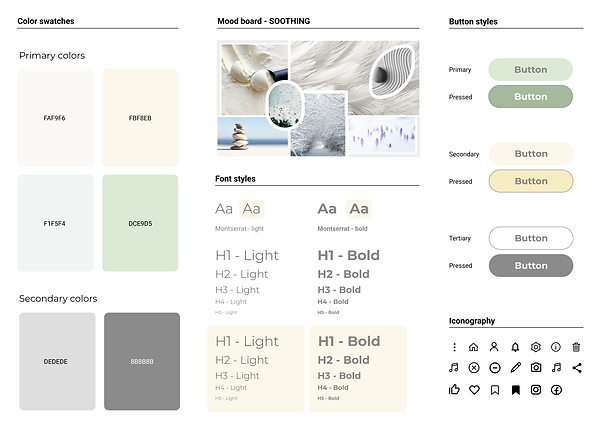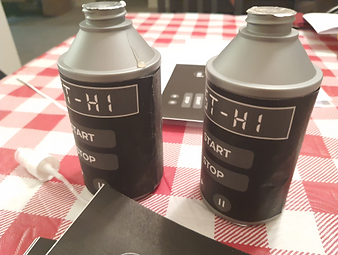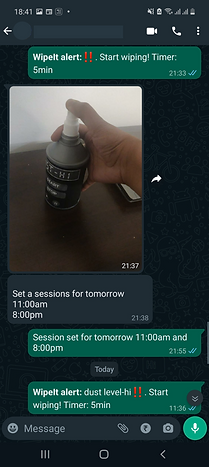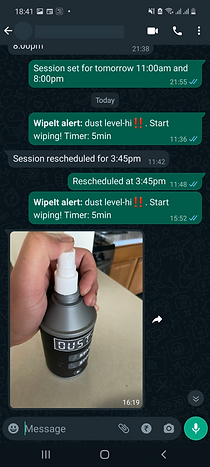
Forming a habit of cleaning one surface daily.
This project is inspired by the book Hooked. Nir Eyal, the book's author, explains how habits can be incepted into users by following a cyclic framework called the hook model.


What is the Hook model?
Designing for behavior change is challenging as it involves deeply understanding the users' mindsets. The hook model breaks down the product interaction into four phases - Trigger, Action, Reward, and Investment, providing a framework for habit-forming products.
-
Trigger: Attract the user's attention toward the product.
(eg: Instagram notifications) -
Action: The user should take Quick and easy-to-perform action to start the hook cycle.
(eg: Tapping on the notification to open Instagram) -
Reward: A pleasant feeling after using the product
(eg: Viewing friends' stories on Instagram) -
Investment: If a user puts in their efforts in the product, they're more likely to come back for repeat use.
(eg: replying to a friend's story on Instagram)

Products designed with the hook model direct their users through four phases in a cyclic process. Once a user completes multiple cycles of these phases, their behavior starts changing. Social media applications like Instagram use this model to hook users to the platform by providing rewards in the form of Stories and Posts.
Using the hook model, I designed a digital and a non-GUI solution to form a habit of cleaning a surface daily. The solution is targeted toward people willing to adopt a clean lifestyle by creating positive habits related to cleaning. The mobile application prompts users to set cleaning sessions daily and makes it enjoyable by rewarding their lifestyle change in the form of redeemable points.


How might we incept the behavior of 'cleaning one surface daily' into people wanting to adapt a clean lifestyle?
Wipeout is a mobile application which enables users to build a healthy habit of cleaning one surface daily. The surface can be anywhere from home, work, or the car! Let's see how Wipeout directs users through the four phases of the hook-model with the help of the story shown below.
-
The story illustrates how a user gets a notification displaying the hazards of having an unclean surface. This triggers him to clean the surface.
-
He takes action by starting a 5-minute wipeout session by clicking on the Start button. He selects 'songs' as the background while cleaning his work desk.
-
The session starts, and according to his liking, a random song starts playing. The randomness of the song is the variable reward.
-
After cleaning the surface, he gets a congratulatory message and receives reward points (Shines).
-
Wipeout takes his feedback on the song and asks him to answer quick-select questions. This makes the user invest in the application.
-
Before he closes the app, he is asked to set a time for the next day's cleaning session. By setting the time he loads the next trigger and completes the cycle.

What features will users need, and which of those will be desirable?
To shape the strategy devised from the hook model, I ideated 17 features that would be a part of the designed solution.
I used Kaco-cards to write down the features and their descriptions, distinguishing them between -
-
necessary features (basic)
-
functional features (performance)
-
desirable features (delighter)

Scoping the solution to create an MVP with the most needed features.
To give shape to the strategy devised for the hook-model, I ideated 17 features that would give shape to the solution. In my scoping, I marked the features which belonged to the hook model - Triggers, Actions, Rewards, and Investments. These features were the most important features which I decided to keep in the solution I was designing.

How will the user navigate on Wipeout?
I structured the features scoped in the MoSCoW framework into a user flow. The diagram shows various paths a user can take while navigating through Wipeout's mobile application. The MoSCoW decisions are highlighted with red features being the most needed MUST HAVEs in the mobile app. The diagram also shows the hook-model's Trigger, Action, Reward, and Investment phases.

How will the features look like - Wireframes

How will the UI look like - Moodbaords & UI style guide
'Clean' is a feeling of freshness. However, the Wipeout app has the essence of various emotions like calmness, self-care, soothing, enjoyment, and discipline. I created five distinct mood boards of these feelings to grab the visual tone of each emotion.

Calm

Self-care

Discipline

Soothing

Enjoyment
Leveraging the Soothing mood board, I created two UI style guides for the elements to be used in the application. The first one had a vibrant hue of violet, seen in the bottom right corner of the mood board. The second style guide captured the overall color tone of the mood board, having a clean feel; I selected the latter. Since Wipeout is a daily-use application, I wanted to portray the UI as clean and minimal as possible, aligning with the feeling of cleanliness.
Selected style guide


UI screens

User gets Triggered by the wipeout session alarm.

User takes Action by selecting the background they would like to listen to during the session.

User gets a Variable Reward in the form of a randomized song catered to their musical likings.

User invests in Wipeout by uploading a photo of the cleaned surface.

User invests in Wipeout by letting the app know which surface they cleaned.

User invests in Wipeout by giving feedback on the background song.

User gets a Reward in the form of redeemable points (Shines)

User loads the Next Trigger by setting the time of the next cleaning session.

User's dashboard shows the number oof Shines earned, and teh dust levels according to cleaning frequency of the user.

User can redeem Shines on the Product page and get discounts on cleaning products.
Part 02 - Non GUI solution
WipeIt

Non GUI solution - WipeIt
As a part of the course, I had to build a Non-GUI (mobile/web) solution for the habit-forming product I had designed. My product, Wipeout, is centered on cleaning. People use many cleaning products like broomsticks, soap dispensers, cleaning robots, etc. Hence, I decided to design a physical product aligning with the mental model of a 'cleaning product.'
Introducing WipeIt - a tabletop cleaning liquid dispenser digitally connected to the Wipeout application. WipeIt has the core functionalities of the Wipeout application. It interacts with the users to set cleaning sessions. Moreover, it has dust censors which collect data on the cleanliness of the surface it is kept on. If the surface is unhygienic, WipeIt notifies the user to clean it. It also has an inbuilt speaker for playing background songs to make the cleaning session enjoyable. Let's look at how to keep the surfaces clean using Wipeit.


Validating the concept of WipeIt
WipeIt was a concept that I had ideated leveraging on the Wipeout mobile application. The concept was built on a few assumptions I had made while designing the product. Based on each assumption's riskiness and level of surety, I mapped the assumptions in a Risky Assumption matrix below. I picked out the three riskiest assumptions, which would devastate WipeIt if they were wrong. These three assumptions were -
-
Users will keep re-locating the device after each wipeout session and load the next trigger.
-
There will be enough space on the surface to place the device and spray the cleaning liquid.
-
Customers will be willing to purchase the device at $30.

Validating the assumptions with Pretotyping experiments
Pretotyping is a method of validating the concept early on in the design phase to test the desirability and/or viability of the product. Testing the risky assumptions is of prime importance as designers must stay aligned with the actual user and market needs. In order to test the risky assumptions of WipeIt, I decided on three prototyping methods and set the success criteria in the form of XYZ statements. (X=how many | Y=who | Z=what)

Experiment 01 - Pinocchio
The Pinocchio experiment is best for physical products like WipeIt. It involves making a low-fidelity mock-up model using available materials to test the physical attributes, in WipeIt's case, to validate the size of the device. I made a mockup model of the device by from a bottle of brake liquid and re-labeled it with the WipeIt device's elements. The relabel includes a 7-segment display for dust level notifications, start & stop buttons, and music control buttons.



Risky assumption: There will be enough space on the surface to place the device and spray the cleaning liquid.
Success criteria: At least 80% of participants will have enough space to place the device on their surface and spray the liquid.
Result: 3/5 participants were able to place the device and spray the liquid on the table. The device needs to be smaller in size.
Experiment 02 - Mechanical Turk
The Mechanical Turk method is used to manually provide the desired output as intended. In WipeIt's case, these outputs were the trigger notifications of cleaning sessions as set by the users. I wanted to test whether users were getting motivated by the triggers to clean and set the next session by relocating the device to a different surface. I gave the device to 5 users and asked them to message me the alarm timings for the next day. As I got the list, I sent trigger messages at those timings and waited for the user to respond by sending a photo of the wipeout session. After the session, I notified them to relocate the device to a different surface and send me the timings for the next day.




Risky assumption: Users will keep re-locating the device after each wipeout session and load the next trigger.
Success criteria: At least 60% of participants will keep relocating the device after the Wipeout sessions.
Result: 3/5 participants relocated the device to a different surface and reverted with new session timings.
Apart from validating the risky assumption, this experiment allowed me to get feedback on the desirability of the WipeIt. I asked the participants whether they found the mock-up exercise useful in forming a habit of cleaning a surface daily. The feedback was highly insightful and gave directions for possible design iterations.
-
The nozzle spray enabled quick action, as expected from the hook model.
-
Participants found the daily reminders redundant, as it was usually one specific time daily. WipeIt should allow the user to set timers for multiple days, which can be changed anytime according to the user's preferences.
-
Although the Dust Level Notification feature wasn't functional in the mock-up model, participants showed interest in the feature. They mentioned that they would also like to get information on the air quality of their room. However, they said that relocating the device was not feasible every time. To capture the dust levels, there could be independent sensors that can be placed on surfaces. The data collected by these can be transferred digitally to the device.
-
2/5 participants found the mock-up model bulky. They had to move a few items from the surface in order to place the device and spray using the push nozzle.

Experiment 03 - Infiltrator
The Infiltrator experiment enables validation of the viability of a product. I kept the mockup at a college and a grocery store to test the third assumption of product costing ($30). Alongside the model, I kept printed business cards with a fake email ID for customers to contact for more information on the product. Providing the contact information added skin-in-the-game to the experiment. I placed a poster beside the model explaining what the device to attract customers to pick up the business cards.
Grocery store - 50 business cards


College store - 50 business cards


Product poster

Business card

Risky assumption: Customers will be willing to purchase the device at $30.
Success criteria: At least 5% of customers shopping for cleaning products will be interested in WipeIt at the $30 price point.
Result: 08 out of 100 business cards were picked by customers shopping in the cleaning aisles of the two stores.

Grocery store

College store
That is how I designed the Wipeout mobile app & WipeIt device, leveraging the Hook model's habit-forming principles.
My key learning from this project was using pretotyping experiments to validate ideas & concepts in the early design phase. It gave me insights into writing well-defined success criteria and measuring the impact caused by the product on users. The Hook model is an excellent tool for designing habit-forming products, and I was encouraged to read more on Nir Eyal's (author of the book 'Hooked') thoughts on behavioral design.
